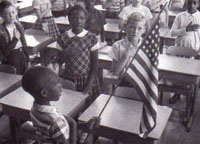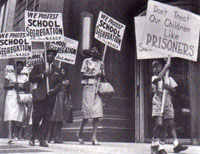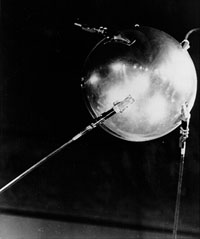|
● Going
to School in America Today
● Education—A Local Matter
● What
an American Student Learns
● Education
in a New Nation
● Learning
to Be World Citizens
● Higher Education
● Selecting
a College or University
● Trends in Degree Programs
● Education for All
Learning to Be World Citizens
 |
|
Black and White Pupils
|
 After
1920, the K to 12 education in America remained very much the same
until World War II. That tragic
event introduced changes that affected every institution in
America—including
the schools. American parents—especially young couples who married
in the late 1940s wanted their children to be educated for the postwar
world. At the same time, American blacks and other minority groups
demanded educational opportunities equal to those of whites. In
1954, the Supreme Court ruled that the practice of segregating,
blacks
into separate schools was unconstitutional. By 1945,
the United States was a nuclear power, a member After
1920, the K to 12 education in America remained very much the same
until World War II. That tragic
event introduced changes that affected every institution in
America—including
the schools. American parents—especially young couples who married
in the late 1940s wanted their children to be educated for the postwar
world. At the same time, American blacks and other minority groups
demanded educational opportunities equal to those of whites. In
1954, the Supreme Court ruled that the practice of segregating,
blacks
into separate schools was unconstitutional. By 1945,
the United States was a nuclear power, a member
 |
|
Protesting against
School Segregation
|
of the United Nations, and a competitor
with the Soviet Union for world influence. American jobs were changed
by new technology (especially by the computer), and American businesses
spread around the globe. Television brought the faces of presidents,
entertainers and people from all over the world into America's homes
each evening. Discoveries by scientists opened new secrets of the
stars and of the atom.
Between 1950 and 1960, more new knowledge was developed than in
all of the world's history before 1950.
 |
|
Discovering Secrets of Stars
|
 |
|
Sputnik
|
 Schools
were asked not only to teach this new information, but to help students
ask their own questions about it. The "inquiry"
method of learning, focusing on solving problems rather than memorizing
facts, became popular. More science courses were added to the curriculum,
some as a result of the orbiting
of the first man-made satellite, Sputnik, by the Soviet Union
in 1957. The federal government began to spend
millions for the development of new science curricula and for training
teachers to use them. (Federal spending would spread to other fields,
too, especially for programs to aid students with learning difficulties.
By the early 1980s, the federal government was spending about 8
to 10 thousand million dollars annually on elementary and secondary
education.) Schools
were asked not only to teach this new information, but to help students
ask their own questions about it. The "inquiry"
method of learning, focusing on solving problems rather than memorizing
facts, became popular. More science courses were added to the curriculum,
some as a result of the orbiting
of the first man-made satellite, Sputnik, by the Soviet Union
in 1957. The federal government began to spend
millions for the development of new science curricula and for training
teachers to use them. (Federal spending would spread to other fields,
too, especially for programs to aid students with learning difficulties.
By the early 1980s, the federal government was spending about 8
to 10 thousand million dollars annually on elementary and secondary
education.)
 But
a good secondary education was no longer enough for many Americans.
In one school district after another, parents insisted on high school
programs that would prepare their sons and daughters for admission
to a university. More and more Americans viewed the university as
the doorway to a medical or law degree, a position in government,
or a management position in a major business office. But
a good secondary education was no longer enough for many Americans.
In one school district after another, parents insisted on high school
programs that would prepare their sons and daughters for admission
to a university. More and more Americans viewed the university as
the doorway to a medical or law degree, a position in government,
or a management position in a major business office.
Previous Page Next
Page
|

